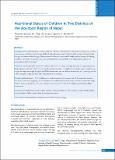Please use this identifier to cite or link to this item:
https://hdl.handle.net/20.500.14356/1866Full metadata record
| DC Field | Value | Language |
|---|---|---|
| dc.contributor.author | Thapa, M | - |
| dc.contributor.author | Neopane, A K | - |
| dc.contributor.author | Singh, U K | - |
| dc.contributor.author | Aryal, N | - |
| dc.contributor.author | Agrawal, K | - |
| dc.contributor.author | Shrestha, B | - |
| dc.date.accessioned | 2023-05-28T07:10:42Z | - |
| dc.date.available | 2023-05-28T07:10:42Z | - |
| dc.date.issued | 2013 | - |
| dc.identifier.citation | ThapaM., NeopaneA. K., SinghU. K., AryalN., AgrawalK., & ShresthaB. (2014). Nutritional Status of Children in Two Districts of the Mountain Region of Nepal. Journal of Nepal Health Research Council. https://doi.org/10.33314/jnhrc.v0i0.396 | en_US |
| dc.identifier.issn | Print ISSN: 1727-5482; Online ISSN: 1999-6217 | - |
| dc.identifier.uri | http://103.69.126.140:8080/handle/20.500.14356/1866 | - |
| dc.description | Original Article | en_US |
| dc.description.abstract | Abstract Background: Nutritional status is a prime indicator of health. Generally, three anthropometric indicators are often used to assess nutritional status during childhood and adolescence: underweight (weight-for-age), stunting (heightfor-age) and thinness (BMI-for-age). Malnutrition in children is a major public health problem in many developing countries. This study was conducted to assess nutritional status among children attending health camps in two mountainous districts in Nepal. Methods: Five hundred and seventy five children below 15 years of age attending the medical camp in Humla and Mugu districts in October 2011 were assessed for nutritional status. For children less than five years, weight for age, weight for height and height for age as per WHO classification, and for children between five to 15 years age specific values of height, weight and Body Mass Index (BMI) were calculated. Results: In Humla district, 28.2% children were undernourished, 8.8% wasted and 22.4% stunted in less than five years. In the same age group, 31.7% children were undernourished, 9.4% wasted and 29.4% stunted in Mugu district. In the age group five to 15 years, thinness was seen in 22.4% and 29.4% children in Humla and Mugu respectively. Conclusions: Malnutrition (underweight, stunting, wasting and thinness) still constitutes a major health problem among Nepalese children, particularly in mountainous regions. Keywords: Nutritional status, stunting, thinness, underweight, wasting | en_US |
| dc.language.iso | en | en_US |
| dc.publisher | Nepal Health Research Council | en_US |
| dc.relation.ispartofseries | Sep-Dec, 2013;396 | - |
| dc.subject | Nutritional status | en_US |
| dc.subject | Stunting | en_US |
| dc.subject | Thinness | en_US |
| dc.subject | Underweight | en_US |
| dc.subject | Wasting | en_US |
| dc.title | Nutritional Status of Children in Two Districts of the Mountain Region of Nepal | en_US |
| dc.type | Journal Article | en_US |
| local.journal.category | Original Article | - |
| Appears in Collections: | Vol. 11 No. 3 Issue 25 Sep - Dec, 2013 | |
Files in This Item:
| File | Description | Size | Format | |
|---|---|---|---|---|
| 396-Article Text-479-1-10-20140207.pdf | Fulltext Download | 487.79 kB | Adobe PDF |  View/Open |
Items in DSpace are protected by copyright, with all rights reserved, unless otherwise indicated.
